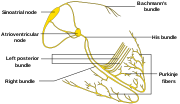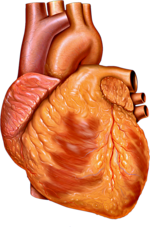 | Unlike the action potential in skeletal muscle cells, the cardiac action potential is not initiated by nervous activity. Instead, it arises from a group... 46 KB (5,420 words) - 07:25, 13 April 2024 |
upstroke of the cardiac action potential there is a large influx of Na+ ions. This depolarizes the cell and shifts the membrane potential in the positive... 20 KB (2,223 words) - 11:45, 9 December 2023 |
 | Sinoatrial node (category Cardiac anatomy) cava. These cells can produce an electrical impulse known as a cardiac action potential that travels through the electrical conduction system of the heart... 24 KB (2,806 words) - 10:15, 7 March 2024 |
 | main contributing current during the repolarizing phase 1 of the cardiac action potential. It is a result of the movement of positively charged potassium... 8 KB (839 words) - 12:27, 1 February 2024 |
Antiarrhythmic agent (redirect from Cardiac dysrhythmia medications) multiple modes of action, which makes any classification imprecise. The cardiac myocyte has two general types of action potentials: conduction system... 20 KB (1,993 words) - 04:31, 21 February 2024 |
Lakatta, Edward G. (2015). "Potential effects of intrinsic heart pacemaker cell mechanisms on dysrhythmic cardiac action potential firing". Frontiers in Physiology... 2 KB (215 words) - 21:48, 16 March 2024 |
 | the hERG channel mediates the repolarizing IKr current in the cardiac action potential, which helps coordinate the heart's beating. When this channel's... 19 KB (2,330 words) - 16:49, 25 March 2024 |
each ventricular systole. Cardiac muscle tissue has autorhythmicity, the unique ability to initiate a cardiac action potential at a fixed rate – spreading... 47 KB (5,784 words) - 11:54, 12 June 2023 |
Cardiac excitation-contraction coupling (Cardiac EC coupling) describes the series of events, from the production of an electrical impulse (action potential)... 11 KB (1,408 words) - 21:41, 13 November 2023 |
 | Refractory period (physiology) (redirect from Refractory period (cardiac)) change in voltage is referred to as an action potential. Unlike that in nerve cells, the cardiac action potential duration is closer to 100 ms (with variations... 11 KB (1,302 words) - 06:37, 23 March 2024 |
Afterdepolarization (category Cardiac electrophysiology) abnormal depolarizations of cardiac myocytes that interrupt phase 2, phase 3, or phase 4 of the cardiac action potential in the electrical conduction... 5 KB (546 words) - 01:14, 29 December 2023 |
 | T wave (category Cardiac electrophysiology) sustained contractions because it forces the refractory period and cardiac action potential firing to be of the same length of time. Repolarization depends... 14 KB (1,763 words) - 13:05, 3 April 2024 |
 | SCN5A (redirect from Cardiac sodium channel) phase of the cardiac action potential. As such, it plays a major role in impulse propagation through the heart. A vast number of cardiac diseases is associated... 25 KB (2,996 words) - 03:48, 11 December 2023 |
 | Flecainide (section Mechanism of action) the entry of sodium in heart cells, causing prolongation of the cardiac action potential. Flecainide was approved for medical use in the United States in... 25 KB (2,632 words) - 13:08, 23 March 2024 |
repolarization peak. Cardiac action potential Vigmond E.J, Tsoi V, Yin Y, Page P, & Vinet A. (2009). Estimating Atrial Action Potential Duration from Electrograms... 991 bytes (119 words) - 05:52, 22 August 2022 |
 | KvLQT1 (category Cardiac electrophysiology) contributes to the repolarization of the cell, terminating the cardiac action potential and thereby the heart's contraction. It is a member of the KCNQ... 12 KB (1,503 words) - 02:10, 17 February 2024 |
 | Purkinje fibers (category Cardiac anatomy) cardiomyocytes with fewer myofibrils and many mitochondria. They conduct cardiac action potentials more quickly and efficiently than any of the other cells in the... 8 KB (839 words) - 02:21, 1 April 2024 |
 | Short QT syndrome (category Cardiac arrhythmia) caused by mutations in genes encoding ion channels that shorten the cardiac action potential, and appears to be inherited in an autosomal dominant pattern.... 24 KB (2,508 words) - 05:54, 25 December 2023 |
 | Amiodarone (section Cardiac arrest) involved in cardiac repolarization during phase 3 of the action potential, so that this blockade prolongs the duration of cardiac action potentials, resulting... 67 KB (6,893 words) - 15:39, 1 April 2024 |
 | Bradycardia (redirect from Cardiac arrhythmia/bradycardia) steady heart beat. In the beginning of the cardiac cycle, the SA node generates an electrical action potential which spreads across the right and left atria... 37 KB (4,063 words) - 03:51, 19 March 2024 |
Sodium channel blocker (category Articles containing potentially dated statements from March 2020) grouped by their effect on the Na+ channel, and by their effect on cardiac action potentials. Class I agents are called Membrane Stabilizing Agents. 'Stabilizing'... 11 KB (1,207 words) - 12:44, 8 November 2023 |
 | Long QT syndrome (category Cardiac arrhythmia) cardiac sodium channel, NaV1.5, responsible for the sodium current INa which depolarises cardiac cells at the start of the action potential. Cardiac sodium... 64 KB (6,615 words) - 00:18, 17 March 2024 |
 | Disopyramide (section Cardiac adverse effects) the increase in sodium permeability of the cardiac myocyte during Phase 0 of the cardiac action potential, in turn decreasing the inward sodium current... 17 KB (1,729 words) - 15:39, 31 March 2024 |





